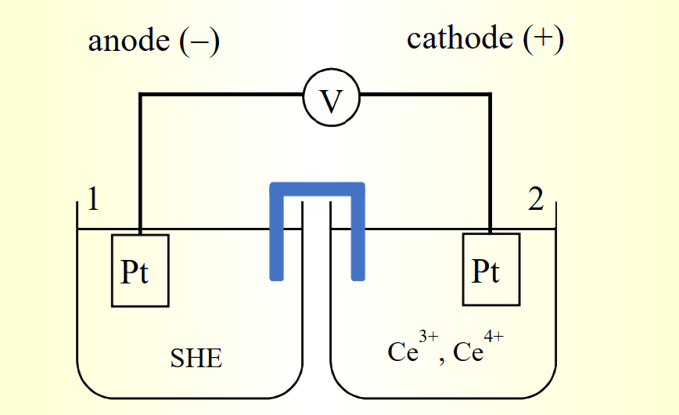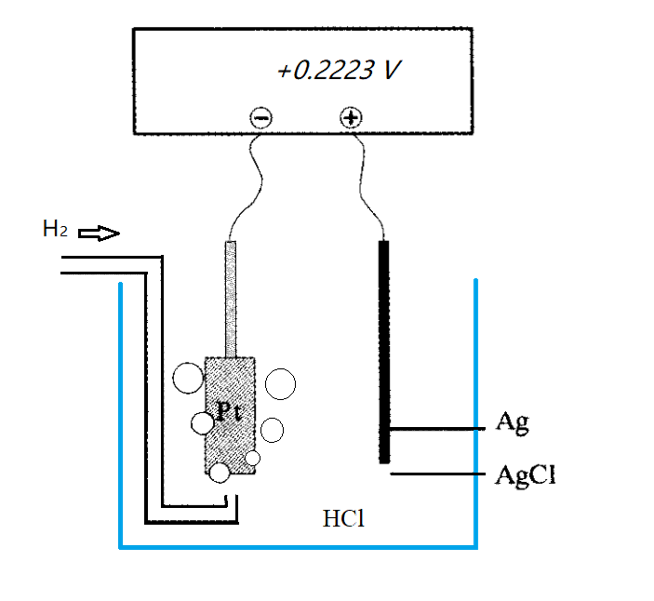Part II: Definition of Standard Electrode Potential
The standard hydrogen electrode (SHE, standard hydrogen electrode) is usually used as the reference electrode. Its electrode potential is defined as ESHE = 0 V.
The potential difference measured with ESHE as the reference electrode is defined as: electrode potential
The potential difference under standard conditions is defined as: standard electrode potential (Eo, standard electrode potential)
Eo Ce3+/Ce4+ = 1.61V → is the standard potential difference of Ce4+/Ce3+ relative to SHE under standard conditions (Fig. 2-1)

Fig. 2-1 Potential relative to SHE
If the primary cell in Fig. 1-1 is connected to an external circuit, electrons will flow from the left half-cell (1) to the right half-cell (2) through the external circuit, indicating that the right half-cell (2) is more likely to accept electrons.Therefore, the electrode potential is an indicator of how easily a substance accepts electrons. A system with a higher electrode potential is more likely to accept electrons (i.e., it is more likely to be reduced).
The standard cell electromotive force of the middle primary cell of Fig. 1-2 can be calculated as follows to be 0.84 V.

According to the writing method of the primary battery we introduced in the first article: the positive electrode is generally written on the right and the negative electrode is written on the left.
The battery in Fig. 2-1 can be represented as follows: Negative electrode | Solution 1 || Solution 2 | Positive electrode (a single vertical line | represents the interface between the two phases; a double vertical line || represents the salt bridge connection between the two liquid phase interfaces)
Understanding the meaning of the magnitude of the positive and negative values of the electrode potential is useful in the future for designing and determining the direction in which a redox reaction proceeds:
The larger the positive value of the electrode potential E: the stronger the oxidizing substance is (the oxidizing substance is easily reduced).
The larger the negative value of the electrode potential E, the stronger the reducing agent is (the reducing agent is easily oxidized).
When two half-cells are connected to form a battery, the electric potential of the battery is positive when the right side is positive (reduction reaction) and the left side is negative (oxidation reaction).
Ecell = E right - Eleft < 0
For the above mentioned primary battery, the tetravalent cerium ion is a stronger oxidant, and the divalent iron ion is a stronger reducing agent. The redox reaction of the cell is usually a reaction between the stronger oxidizing agent and the stronger reducing agent to form a weaker reducing agent and a weaker oxidizing agent.
Consider first the following reaction example of equation (7). A silver chloride solid gains an electron, reduces to a silver atom and releases a chloride ion.
This one is usually called the reaction at the silver/silver chloride electrode. The s and aq in parentheses represent the solid state and the state dissolved in water, respectively. Since, the potential of the half-reaction cannot be measured separately, to measure the potential of the silver/silver chloride electrode, choose to use the hydrogen electrode reaction as the reference standard of the electrode potential, and obtain the electrode potential of the silver-silver chloride electrode by forming a Harned cell as shown in Fig. 2-3.

Fig. 2-3 Schematic diagram of Harned cell electric potential measurement};
The reaction equation of the hydrogen electrode is expressed by equation (8).
This battery can be simply represented as:
Here, the vertical line Ι represents the interface between two different phases. The Cu at each end indicates the copper conductor between the electrode and the potentiostat. It has been agreed that when the cell equation is written in the above manner, the electric potential E is determined as the potential of the conductor to which the right electrode is connected, minus the potential of the conductor of the left electrode (this has been specified to enable this to be done).~
The overall reaction of the battery is a combination of equations (7) and (8), and the battery electromotive force E can be expressed by equation (9).

(9)
Or it can be expressed more simply as
Eo(AgCl/Ag) = 0.2223 V[1]
(11)
The standard electrode potential discussed is the electric potential of a Harned cell as shown by the substances involved in the cell reaction in the standard state, here denoted by Eo. The values of the standard electrode potential for silver chloride electrodes are listed in literature [1].
Reference
[1] A. J. Bard, R. Parsons, and J. Jordan, Stand Potenrials in Aqueous Solution, Marcel Dekker, New York (1985).

